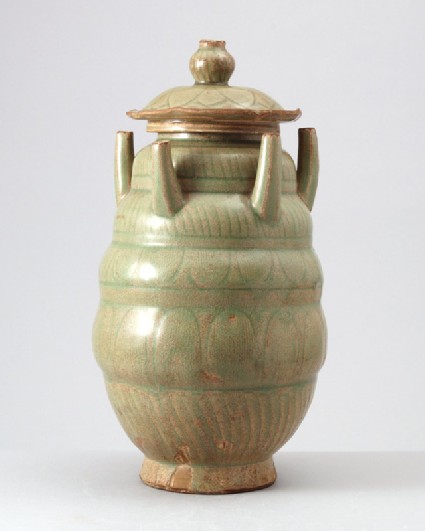Search Results: objects
Show search helpGreenware funerary jar with five spouts
- loan
-
Details
- Associated place
-
Asia › China › Zhejiang province › Longquan kilns (place of creation)
- Date
-
11th century (1001 - 1100)
Northern Song Dynasty (AD 960 - 1127)
- Material and technique
- stoneware, thrown, with incised and combed decoration under a green glaze; spouts hand-modelled and luted to the jar with slip; unglazed base; glazed rim
- Dimensions
-
with lid 32.3 cm (height)
without lid 27.8 cm (height)
lid 12.8 cm (diameter)
- Material index
- Technique index
- Object type index
-
container › vessel › pot › burial-pot,
- No. of items
- 2
- Credit line
- Lent by the Sir Alan Barlow Collection Trust.
- Accession no.
- LI1301.308
-
Further reading
University of Sussex, and Arts and Humanities Research Council, The Barlow Collection, supervised by Regina Krahl, Maurice Howard, and Aiden Leeves (Sussex: University of Sussex, 2006), no. C305
Glossary (4)
glaze, luted, slip, stoneware
-
glaze
Vitreous coating applied to the surface of a ceramic to make it impermeable or for decorative effect.
-
luted
The fusion of parts of ceramics using dilute clay slip.
-
slip
A semi-fluid clay applied to a ceramic before glazing either to coat the surface or for decorative effect.
-
stoneware
Ceramic material made of clay which is fired to a temperature of c.1200-1300⁰c and is often buff or grey in colour.
Location
-
- currently in research collection
Objects are sometimes moved to a different location. Our object location data is usually updated on a monthly basis. Contact the Jameel Study Centre if you are planning to visit the museum to see a particular object on display, or would like to arrange an appointment to see an object in our reserve collections.
Publications online
-

The Barlow Collection
A related jar without cover in Japan is dated in accordance with AD 1080 by an inscription engraved before firing. The piece is similar to the jar [LI1301.211], also in the Barlow Collection. The cover on the present piece is, however, unusual in fitting over the neck of the jar rather than inside it. It is also rather large in proportion and probably belonged originally to a another, larger jar.
The tall ovoid jar has a low curved section below and four bulging bands further up, a cylindrical neck and a splayed foot with a low footring. Five tall polygonal tubes are attached around the upper part. The domed cover fits over the neck of the jar and has an everted wavy rim with four cut-out notches and a hollow, bud-shaped knob. The central part of the jar is decorated with a design of incised and combed petals, which is repeated on the cover. The upper two registers and lowest part of the jar and the knob of the cover are incised with vertical ribs, those at the lower part joined at the top to form simple petals. The foot and neck are plain. The piece is covered with a light green glaze which leaves free a wide ring inside the cover and was scraped from the footring and base. The biscuit has burnt a reddish tone.
© 2013 University of Oxford - Ashmolean Museum








